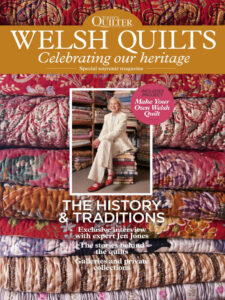
Wales keeps cropping up in my life lately. It started with reading the Black Beacons/ DCI Evan Warlow series of mysteries. Then Today’s Quilter had a supplement about Welsh Quilts. I found it when I was going through my big stack of magazines and became entranced! There is a connection between Welsh Quilts and Amish Quilts about which I never knew. I don’t see the special supplement on the Gathered.how site, but they do have a short article on Welsh quilt patterns.
When I started quiltmaking, Amish Quilts were very popular. Roberta Horton came out with her Amish book, An Amish Adventure**. Solids filled an entire room at the Cotton Patch and classes about Amish Quilts abounded. The Esprit collection was a major collection of Amish Quilts. The deYoung museum had a fantastic exhibit of Amish quilts called Amish Abstractions in 2009. There was a huge and gorgeous coffee table book, Amish: the Art of the Quilt**, that came out all about Amish quilts.
My first quilt was mostly made of solids, inspired by the Amish movement, though as my confidence grew, I added in a few prints.
I love the simplicity of the designs, both the Amish and the Welsh. I was really interested when I saw that Welsh quilts had similar patterns. I had seen a few Welsh quilts before, but never made the connection until now.
The Today’s Quilter supplement provided a few resources, which I have either bought or borrowed from the library. Making Welsh Quilts** was available used for a good a price. It had an overview of Welsh quiltmaking and a few thoughts on the connection between Welsh and Amish quilts. This book got me started in learning more. However it is a project book, so most of the text is taken up with projects.
Next I borrowed Dorothy Osler’s Amish Quilts and the Welsh Connection** from the library. I have just started it. I am reading it slowly as it is very academic and I want to be sure I take in the text. So far, I am seeing that immigration from Wales to Pennsylvania brought the quilt designs to the Amish, but don’t take my word for it yet, as I have only just started reading. Ms. Osler also wrote Traditional British Quilts**, which may be one I want to read next. Welsh Quilts: A Towy Guide (ISBN: 0952579014) is also listed. I may try to read that one next.
There are also a couple of organizations listed. One is The Quilt Association, which is located in Llanidloes, Mid Wales. The organization houses quilts from the local area and concentrates on caring for them. They have an annual summer exhibitions on various topics with a program of workshops as well.
The Ceredigion Museum is based at the Coliseum in Aberystwyth and has some fine examples of Welsh quilts in their collection. The quilts are not on permanent display, but can be viewed by prior request.
The Welsh Quilt Centre is in West Wales. I had trouble getting to this site, so you might have to try a few times. The description was to open a center to celebrate and promote the wider understanding of Welsh quilts.
If you are going to Wales, there are a number of places you can visit white travelling.
There is a lot of talk in the Modern Quilt world about not using batiks with ‘quilting’ cotton. This is nonsense, of course, but the myth persists. In making Welsh Quilts, contemporary quiltmakers get an amazing example of mixing fabrics. A quilt called Red Baskets, from c.1870, is described as “…an interesting combination of ombre suiting fabrics…, with basket blocks in contrasting red flannel.” (pg.29)
There is a lot to like about this topic. The designs in both the Old Order Amish and the Welsh Quilts are simple, and bold. There is no way to separate the designs from modern art designs. Piet Mondrian comes to mind, though there are others as well. Of course, the designs are different, but I see the similarities.
There are also a lot of quilting designs that can provide excellent inspiration for your own quilting.
I find this to be an interesting topic and hope you do as well. This is not a comprehensive guide, but a little taster of a topic about which you may never have thought.
**N. B. : Obviously, you should shop at local quilt shops and small businesses. However, if you are too busy or can’t find what you need there, I use Amazon affiliate links and may be paid for your purchase of an item when you click on an item’s link in my post. There is no additional cost to you for clicking or purchasing items I recommend. I appreciate your clicks and purchases as it helps support this website.